Debate on Maxwell’s Southern Hills vs. Oklahoma City
Jay Flemma – for Oklahoma City Golf and Country Club
Chris Clouser – for Southern Hills Country Club
Introduction
Jay (OC) – When discussing Perry Maxwell’s greatest courses, the conversation is incomplete if Oklahoma City Golf and Country Club, (OC), is omitted.
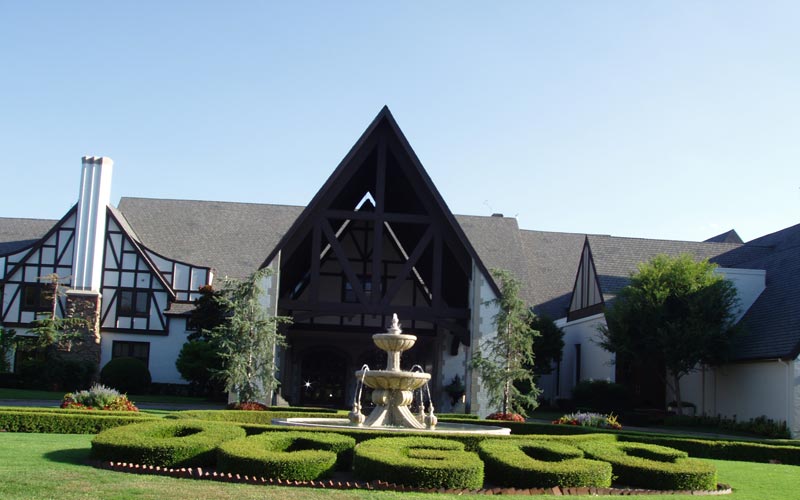
Though OC has hosted only one USGA Championship, the 1953 U.S. Amateur, its architectural design is among the greatest in the country, and the club should be regarded as an important part of the rich tradition of not only Maxwell, but Alister Mackenzie as well. Its clever routing showcases a varied terrain: at times rugged, at times idyllic, and at times simply a seamless part of a charming neighborhood. It blends smoothly into the landscape, feeling eminently natural.
The greens are some of the best Maxwell and Mackenzie ever designed: sometimes sloping front-to-back, and at others side-to-side, and at all times featuring insidious breaks. The fairways have marvelous undulation. The bunkers are as big and bold as Southern Hills, and are more intricate aesthetically, and the green surrounds are more varied, especially the front nine.
While I concede that Southern Hills may be a better major championship venue because of its size and difficulty, and also that it has a richer history than OC, I think OC is a better design architecturally, and is more exciting and enjoyable to play. It may not have the history, brute length, narrowness, or four-inch rough of its Tulsa cousin, but it’s still every bit its equal in course design.
Chris (SH) – Perry Maxwell was the premier golf architect in Oklahoma for many years, and he laid out and constructed the top course in each of the largest cities in the state. Southern Hills was built in 1935 and 1936 in Tulsa, and a few years prior Maxwell built Oklahoma City with some minor assistance from Alister Mackenzie. Due to this affiliation with Mackenzie, OC has recently been getting some additional interest. Some even say the course exceeds Maxwell’s preeminent design in the state. Moreover, major championship venues are often easy targets for criticism – nobody likes rooting for the big boy on the block, and Southern Hills is no exception – but when one looks at the substance behind the reputation they will realize how special a course it really is.
Routing
Jay (OC) – Surrounded by an opulent but charming neighborhood, Oklahoma City is cozily tucked into a roughly rectangular parcel. With the clubhouse at the lower-right corner of the property, the out-and-back routing seems both intuitive and ergonomic. A road bisects holes ten through thirteen from the rest of the course.
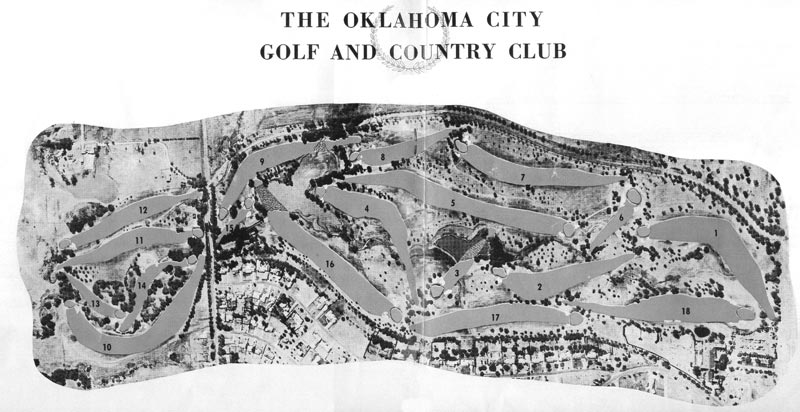
Above is the 1953 routing. The numbering of the holes on the left side of the road has changed. The holes marked twelve, thirteen, and fourteen in the picture above, are now played as ten, eleven, and twelve. The holes marked ten and eleven are now thirteen and fourteen.
I like an out-and-back routing. We’ve relied on the doctrine of symmetry far too long in this country, and an out-and-back routing also echoes the layouts of the great seaside courses of the U.K that gave birth to the game. Most importantly at OC, it’s what fit with the parcel of land. It’s a credit to Maxwell and Mackenzie that they did such a great job fitting eighteen outstanding holes in such a tight space.
Next, OC has great vertical movement in the earth – i.e. fairway undulations – more interesting than the more rolling, but slightly flatter fare found in its Tulsa cousin. It also has plays into the teeth of the toughest parts of the terrain. For example, the tee shot on four intimidates the golfer to carry rugged terrain then the hole gently bends left to a downhill approach to a green sloping front to back in an idyllic lakeside setting.
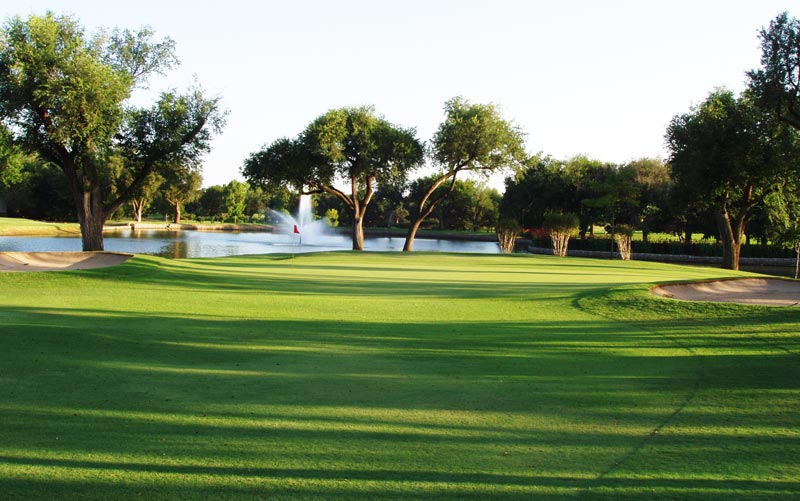
At the par-five fifth hole, this punchbowl green sits below fairway level and is semi hidden on the left side by a knoll and guarded by a bunker on the right.
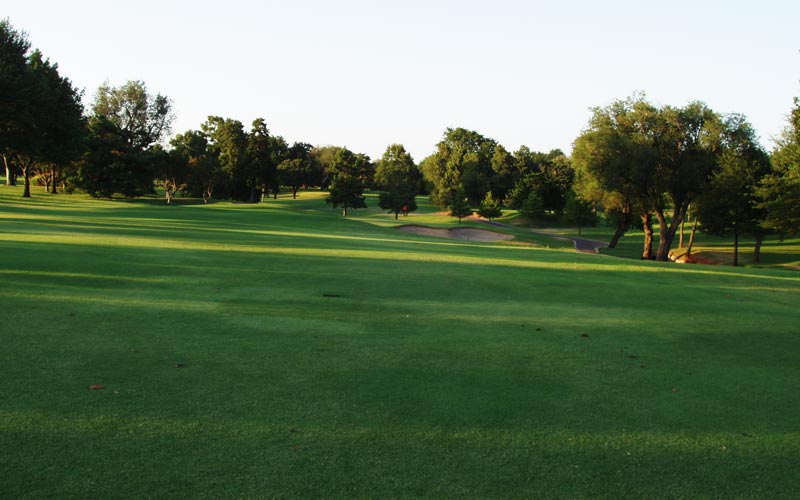
And at the short par-four fourteenth, we see one of Maxwell’s favorite shots, a severely downhill approach.
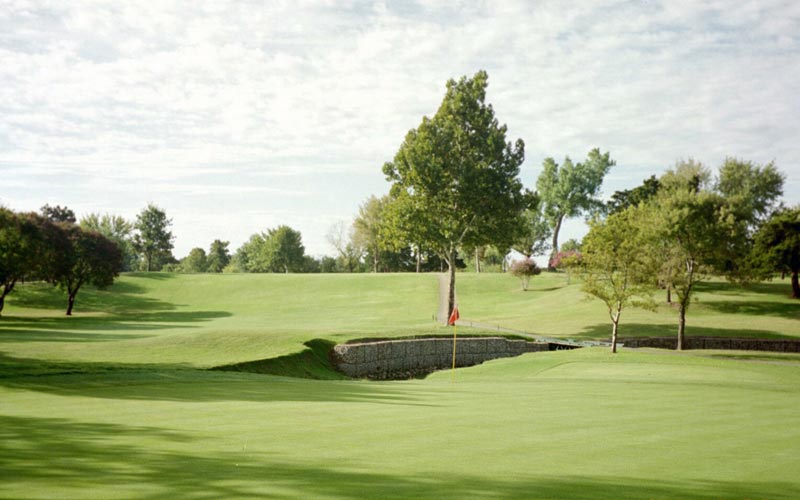
Also, with wider fairways, OC has more angles of attack, (and therefore playing options), since the course isn’t clogged with trees and four-inch rough. In places, Southern Hills is straight-jacketed by ubiquitous trees and rough. Even with the removal of 2,500 trees in preparation for the 2007 PGA Championship, one cannot see across vast expanses of the course like at OC.
Finally, Maxwell and Mackenzie used some holes at National Golf Links of America as inspiration for the strategic challenges the golfer would face, so OC is a thinking man’s golf course. Even though Mackenzie was reputed to be “Anti-National†at the time – it was his competition, after all, and it was superb – Mackenzie knew that Maxwell’s reverence for National and, better still, his sublime ability to translate NGLA’s golf strategies on the ground was a formidable asset. I’ll refer you to Clouser’s The Midwest Associate, for a chapter and verse discussion of those holes in particular.
Chris (SH) – Some may say that the golf at Oklahoma City is more intimate and that Maxwell did a better routing job of holes than at Southern Hills. I won’t disagree that Maxwell did a fine job of shoehorning the holes into the smaller property, which is a sign of his genius. But he had a much larger piece of land to work with at Southern Hills. This space was used to its fullest with Maxwell going to the best pieces of the property; the hill on the south end of the course, the stream that ran through the middle of the site, and the rolling terrain on the east end of the property. Using these, he was able to provide sweeping vistas of the site and the surrounding area while also taking the player to the best golf terrain. With this vastness, some of the so-called intimacy may have been eliminated. At OC the nature of the site mandates intimacy, because there are no exciting elevation changes, with only some slightly rolling terrain that was used well by Maxwell.
Green Complexes
Jay (OC) – Oklahoma City also has greens contours equal to the superb greens at Southern Hills, relying more on the severe natural undulations than micro-movement and benching into a hillside. Here, for example, we can see the undulations in both the green and fairway at the par-five sixteenth. The fairway looks like a ski run!

Here’s another great view.
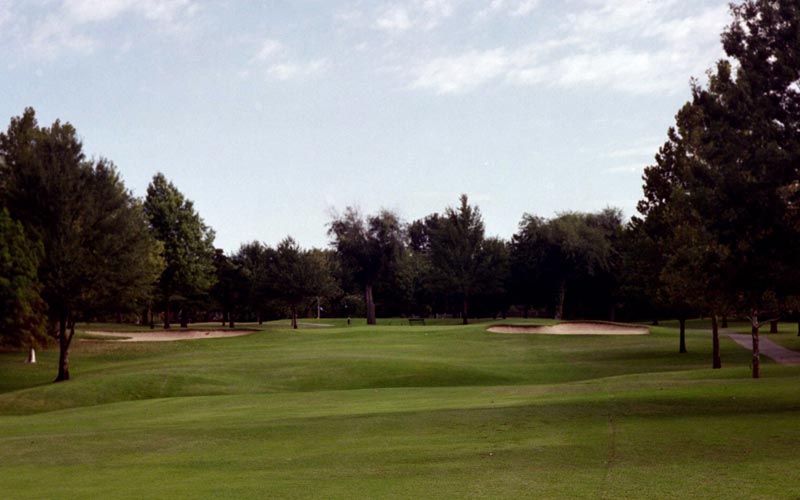
Like Southern Hills, many of the greens at OC slope front to back, side to side, often times, both ways. We see below the wicked, potato-chip shape of the 13th. It’s really three little greens in one, the old-school strategy for a par-five and a solid tenet still today.
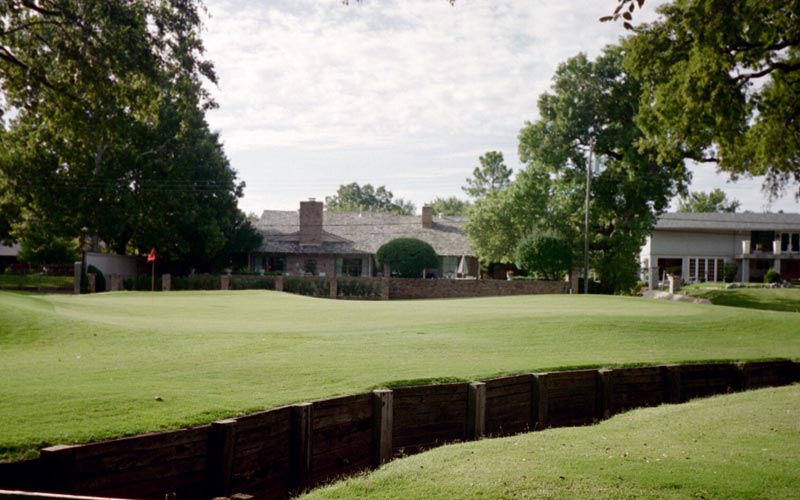
As Chris mentioned, the second green is also one of the best. The picture below is taken from the rear of the green looking back down the fairway. You can see it slopes away from the player in his approach, a feature we should embrace more often in modern design since it makes player’s think more about strategy and offers further defense to the golf course without gimmickry.

Chris (SH) – Some arguments for OC point to the green sites as being better than their cousins in Tulsa. I cannot disagree if someone makes the argument that they are different in style, but better is quite a reach. Some of the greens at OC are quite nice. The reverse sloping of the second is a green that any course would like to have. The slight interior contouring of the fourth and sixteenth greens also provide some excitement. But at Southern Hills Maxwell knew that he did not need such elements in his green designs. He had several natural green locations throughout the course, especially when using the tilt of the land. All of the greens that are benched into the southern ridge contain significant slope and each has their own internal contouring that is the equal to what is found at OC. A prime example is the fifth green, which flows with the natural slope of the hole from left to right, and carries that all the way into the green design with a slight knob on the right side of the green.
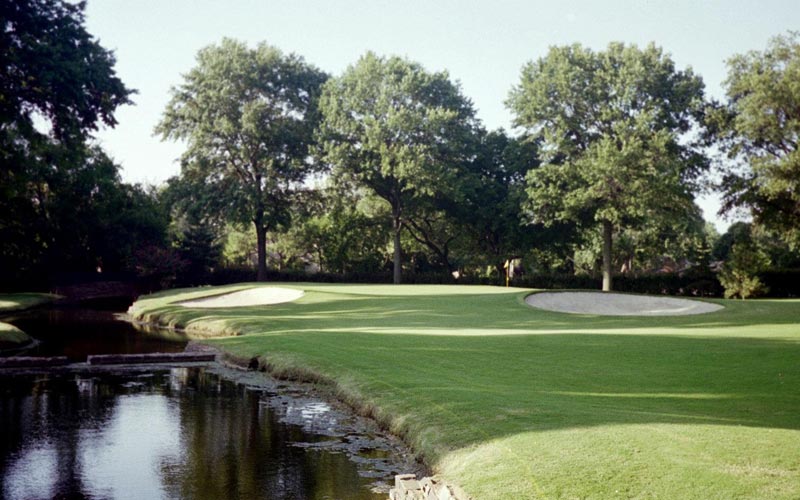
The sixth is set in a natural amphitheater.
Natural Setting
Jay (OC) – Oklahoma City has wider vistas and a more natural, open feel: excepting the view of the first tee at Southern Hills, OC is prettier. It looks more to my eye like the front side of Crystal Downs than the back, rugged hurly burly, terrain and open vistas.
Chris (SH) – Another point by the advocates of OC is that the course at Southern Hills feels like a big “championship†course with the conditioning and alterations over the years by the USGA and in-house personnel while OC is much more like a traditional country club. First off, it is not like OC is a small town muni course. OC has more than an ample budget for maintenance. The rough is more than adequate and the greens are equally as quick. Southern Hills has the reputation of being maintained at a high level, but in the two times I visited the course, the course was maintained at approximately the same level as OC. But Southern Hills does ramp up the toughness when the big boys come to town. To Southern Hills’s credit it can be stretched long enough for the pros and still play at a reasonable length for the regular guy when one looks at the variety presented throughout the round.
Favorite Holes
Jay (OC) – Boy, talk about giving a starving man a menu! Two, four, nine, ten and fourteen are my favorite par-fours. Two and four have the best terrain, nine is a staple of the Maxwell repertoire, requiring a long straight tee shot to reach the knee of a sharp dog-leg. It then plays down hill to a green canted severely left to right.
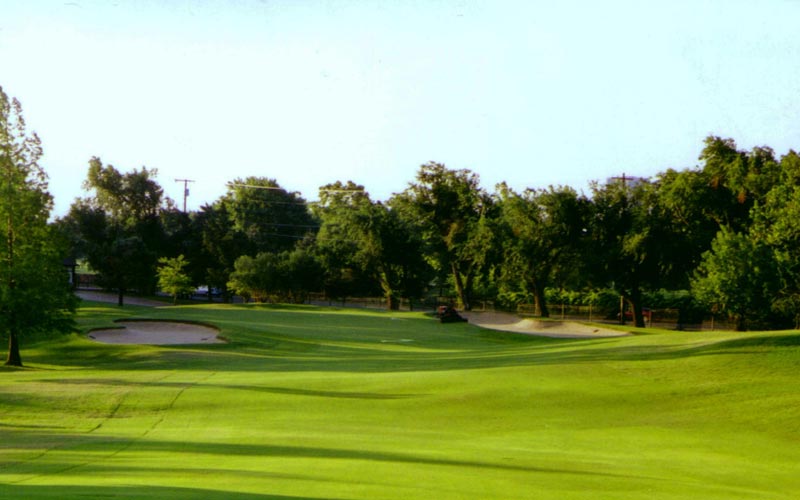
Next, three is a tough par-three with a hurly-burly green.
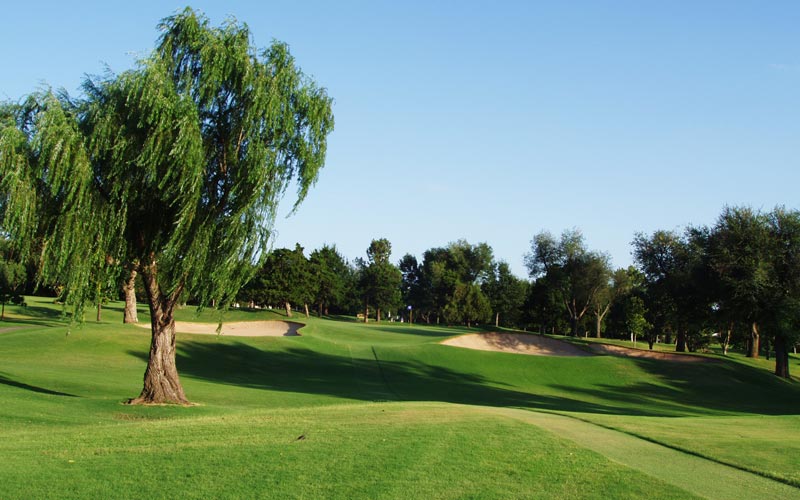
Last, I also like the par-fives. It’s fun hitting a downhill “one-bounce-and-on†approach to the punchbowl green at five, and the great swooping curve of the gorgeous par-five 13th rumbles over canted terrain as it forms the shape of the letter “J†as seen from the air…of course I’m going to like that.
Chris (SH) – Hole 14; This is perhaps the most overlooked hole on the course. The green on the fourteenth might be the best on the course, with its slope running from front left to back right in a Reverse-Redan type fashion. The slightly elevated tee creates a shot of over 200 yards to the green below. As with the rest of the course, the green is heavily protected by sand. This is perhaps the one par three where the dominant wind is a true help as it will allow the player to fade the ball gracefully onto the green surface.
The most satisfying shot on my one round at Southern Hills was a strong three iron that landed on the front right of the green and rolled ever so slowly to the back left portion of the green. The right side of the green tilts further away, the farther back on the green you go. Difficulty will be found on anything to the left side, with the most difficult being back left. Back right pin locations might actually be the easiest even though they will be the farthest, and they may also provide some wonderfully entertaining shots.

Looking back up the fourteenth hole with the green contours in full view coming towards the player.
Hole 17; This hole may be the best short par four in Maxwell’s career, which is quite the statement. The terrain on the hole shifts from left to right towards a creek that should only be in play if a grave error is made by the players. With the green raised above the surrounds it eliminates the advantage of the true bomber that finds a short pitch from the fairway below. But the wise player who relies less on brawn can have an ideal view of any pin from the left side of the fairway.
The contouring of the green is the most complex on the course, with the front portion sloped towards the player and the back side of the green seeming to run away. Without question, pin positions on the left side will be much more difficult. The green itself is very narrow from front to back, but the length from right to left is something that is unique to Southern Hills. Wherever the player hits their approach from, leaving it short is not an option as several bunkers protect the front of the green.
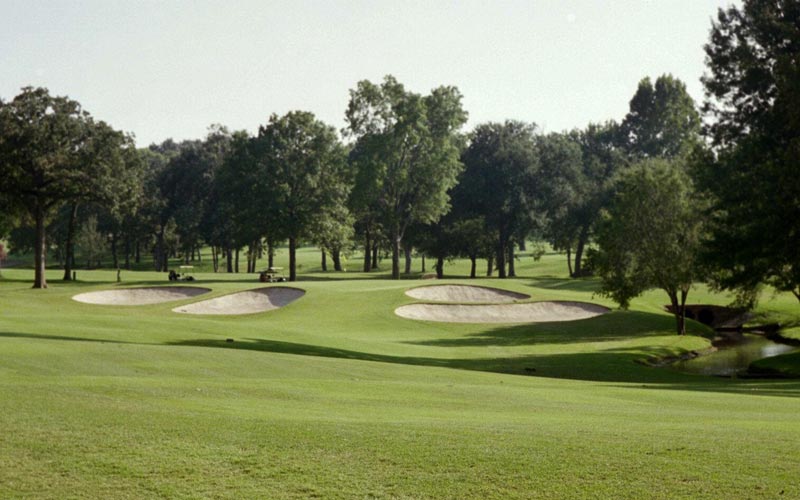
The approach into the seventeenth green.
Hole 12; The drive of the hole is actually uphill to the crest that runs from a hill to the right of the hole. To the left at top of this crest is also the lone fairway bunker that is the pivot point for the dogleg. If one plays along the left side they will get a clearer view into the green and be able to attack it along the length of the putting surface. To do so will require a tee shot of 260 or more yards. From the right, the hole plays down hill to a green surrounded with more trouble than a teenaged television star.
To the right of the green is the creek and a shaved bank that will deposit anything just slightly off line into the water. I have seen this first hand. To the left are three bunkers that surround the green. Most players will be hitting mid-iron into the green, so the chances of error will increase. Also a factor will be a lie that has the ball above the player’s feet. If they do not compensate or go to the other extreme trouble will be found. Perhaps one suggestion to improve the hole would be to extend the left side of the fairway and eliminate a few overhanging trees to provide a truly clear view into the green for those that hit their tee shot to a specific location. The green is heavily sloped from left to right and towards the water. There are a couple of knobs in the putting surface as well and it presents a real challenge, but if the player makes it to this location then they will be more than thankful to take a par.
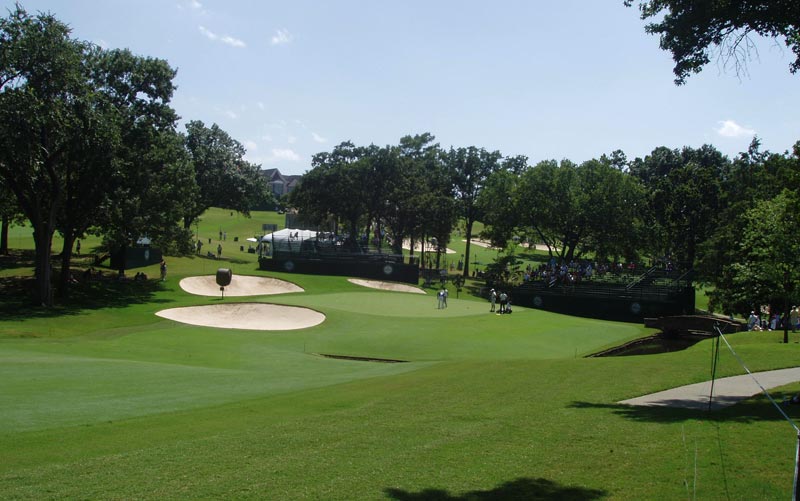
The twelfth green during the 2007 PGA Championship.
Jay’s Favorite Hole at Southern Hills
I’m going to go with my gut, rather than pick the toughest hole – which is twelve – and choose eighteen. I love a big, tough par-four finisher. It’s the last hole of the day, and it should rightfully demand your best drive and most precise second shot of the day to close the round: out with a bang, not with a whimper. Architecturally, it should also be a summation of all that came before. Eighteen does that. A long, precise drive must find the right slot in the dog-leg and avoid the cross bunkers and burn, to offer a good angle uphill to a fiercely contoured green precariously perched atop a plateau. How many missed putts were there on Championship Sunday 2001? Plus, the front and right bunkers are monsters, up and down out of either is brilliant.
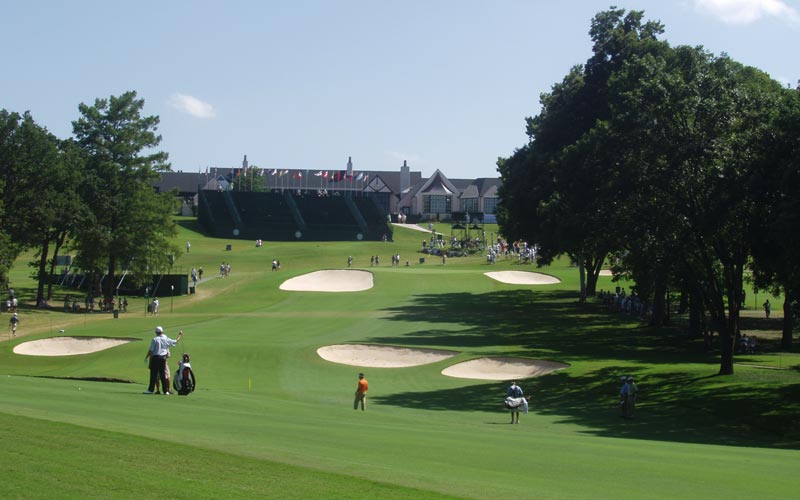
Honorable Mention: One. It’s already cool sending a ball high into the sky against the Tulsa skyline and the endless horizon on the edge of a vast plain, but when the refinery smokestack on the horizon erupts, sending a candy-cane flame into the sky, the tee shot off one becomes as surreal an experience as anything in the golf world. Can you tell we’re in oil-man country?
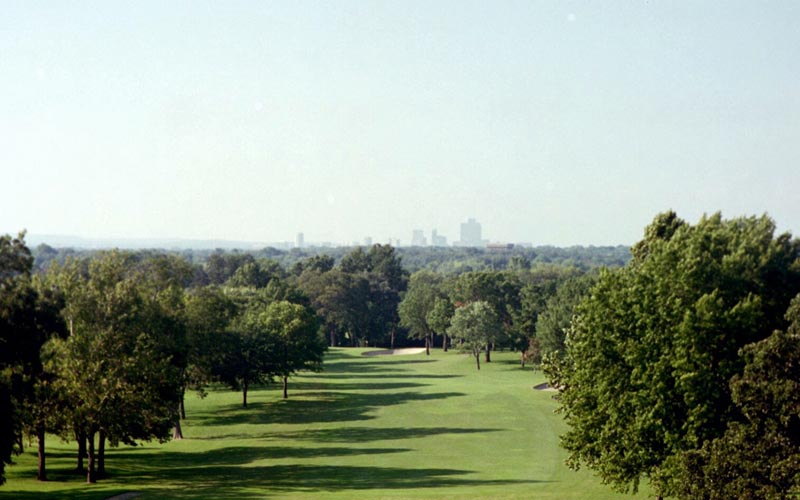
Chris’s Favorite at Oklahoma City
Hole 2; The attraction of this hole is clearly the green complex. The green slopes significantly from front to back in a way that is not familiar with many courses around the country. The entrance to the green has several small humps and bumps that lead into the putting surface and makes it perfect for a links style punch and run shot. An aerial shot will not stop on the green. It is the perfect style of green to eliminate the advantage of the longer player. The dogleg nature of the hole also provides some strategic elements as the player that plays along the right side can actually see the entire green complex where players to go wide left cannot see the real entrance into the putting surface: a truly ingenious strategic hole without a single fairway bunker.
Jay’s Rejoinder to Chris’s Argument
I thought for sure Chris would mention that OC has the zaniest practice field in golf. People are tucked behind a screen of trees at a right angle to the first hole and hit shag balls into the fairway, taking care not to hit the golfers as they walk past after teeing off. “Once you get past the striped yellow balls, the course is amazing,†said one irreverent wag.
I’ll also take a moment to offer one other alternative to one of Chris’s thoughts in his great book on Maxwell, The Midwest Associate. He wrote that OC marked the end of the first part of Maxwell’s career. I’d refine that thought by submitting that OC actually marks the beginning of the second part of Maxwell’s career, his collaborations with Mackenzie. This collaboration resulted in bunkering, routings, and greens that were even better than the excellent work Maxwell had already produced on his own, and took his already sublime talent to an even higher level.
Chris’s Rejoinder to Jay’s Argument
I will have to agree with Jay on some of his points. There is something about playing at Oklahoma City that is different from Southern Hills and that variety is clearly what the game is about. I also concur with his statements about the bunkering on the two courses. The modern moonscapes at Southern Hills are not the most pleasing to the eye, even if they serve their purpose in a championship. I also have to give him the nod in regards to the tree issue at Southern Hills. The sylvan residents of the site are helping to hide one of the truly special designs in the country. Wider playing corridors would change the impression of the course and drastically open up the playing possibilities on holes like the second, third and twelfth. In closing, trying to pick one course over the other is like trying to pick a favorite child. Each has their strengths, weaknesses and quirks but when viewed in their entirety it is difficult to argue with either choice.
Conclusion
At the end of the day, we are splitting hairs between two truly great courses: one timeless because of its USGA and PGA tournament history, but another which should be treated with equal reverence because of its architectural heritage and cunning design features. OC, which has held only one USGA championship, holds up remarkably well against an eight-time major venue. Even though much of Maxwell’s work at Southern Hills and Colonial may have been softened, it has been preserved carefully at Oklahoma City.
Finally, is there a course that Mackenzie worked on less appreciated than at OC? Rank and file fans all know Augusta, Cypress Point, and Crystal Downs and speak of them in holy whispers, but for some reason Oklahoma City is overlooked. Moreover, while some say Mackenzie merely made a few site visits and limited much of his work here to granting his imprimatur upon Maxwell’s efforts, I find it hard to believe that OC could feel so much unlike Dornick Hills, Southern Hills, or Colonial without Mackenzie. His influence is there in the bunkering and routing, and not only OC but all Maxwell’s designs going forward had to be affected substantively in some way, large or small, due to the collaboration. You can’t work with a master like Mackenzie and have some great ideas rub off. Future research should be conducted to analyze this impact on Maxwell’s later designs.
The End








